The tips below are geared towards birdwatchers of any age and skill level, although the practice of bird sketching can be especially useful for new birders in serving to strengthen your identification skills. Keep in mind that you are drawing from real life, not aiming for the precision and quality you see in the birding field guides. My goal is to make you comfortable sketching without quality judgments and my hope is that you’ll grow to enjoy the practice of sketching as a relaxing and fulfilling hobby!
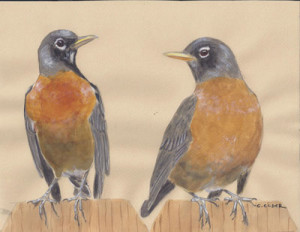
American Robins
So here are your quick tips for sketching backyard birds:
- Wait quietly and patiently so the birds will get used to your presence. Learn the habits of the species in your area so you will know when the best times are to observe them and where they tend to gather.
- Find a comfortable position and orient yourself so that your sketchbook is in the shade or shaded by your body, for the glare of the sun on white paper can give you a headache and also startle the birdlife.
- Bring along some bird seed or crackers to entice birds to land near you.
- Sketch lightly and loosely, keeping your pencil moving and avoiding wasting time erasing your marks.
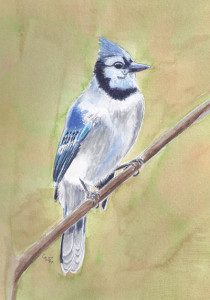
Blue Jay
- If no birds are around, just doodle and wait – draw some shapes or basic body forms in different positions as practice.
- The faster the birds move, the smaller you should draw. Your thumbnail sketches can be as tiny as an inch or two.
- Glance quickly back and forth between your paper and your bird. Sketch, look. Sketch, look.
- If there are multiple species, focus on just one at a time until you’ve sketched it in every pose it takes.
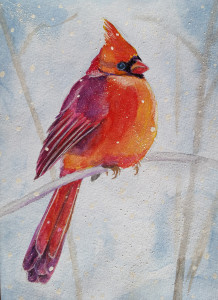
Northern Cardinal
- Start a small sketch and when your bird moves, just start a new one in the birds’ new pose. As your bird or another one comes into one of the same poses, just start up where you left off until each sketch is complete.
- Remember that the most important identifying features of birds are generally the bill shape and facial patterns, followed by color patterns on the body, so focus on these first in your sketches.
- Don’t worry about drawing legs and feet, they are rarely diagnostic. Instead watch for the field marks that your guidebook mentions and try to see and draw those.

Stripe-headed Sparrows
- To avoid overwhelm, try drawing just one anatomical feature of the birds you are observing, like their bills or eyes. Sketch them from as many angles as you can in order to gain a full understanding of their form from any view.
- Practice sketching a species at different distances to learn its unique features visible both close up and far away.
- If birds are moving too quickly to draw, just observe them intently and try sketching from memory once they’re gone.
- Try whispering the birds’ identifying features to yourself – an orange crown, black eye stripe, short finch-like bill, etc.
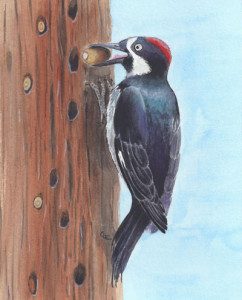
Acorn Woodpecker
- Written notes are just as useful as drawings. Note the bird’s colors, sounds and behaviors in your sketch book.
- If, when you are done sketching and you hate what you’ve drawn, don’t fret! It is in the act of drawing that you learn. Place your energy on the process not the product, remembering that the act of sketching is just a method to focus your attention on a bird longer than you might if you were just glancing at it quickly enough to see its field marks to make an identification. Ideally, you are aiming to develop a deeper understanding of the form and behavior of the birds you sketch.
- Always carry your sketching supplies with you so they’ll be available at a moment’s notice!
CLICK HERE TO LEARN ABOUT MY ONLINE COURSE: SKETCHING BACKYARD BIRDS FOR BEGINNERS
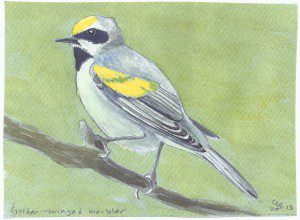
Golden-winged Warbler
More Bird Resources on this Website
Here are some more stories, videos, and bird sketching resources I’ve written.
World Migratory Bird Day and Why Birds Migrate
My Costa Rica Birding Big (sketching) Day
Identifying Warblers in the Spring
A Black-headed Grosbeak Nest (video)

Blue-winged Warbler
Did You Enjoy This Story?
If you’ve found value in this story and believe in my mission to educate youth and adults alike on the value of nature, I invite you to make a donation to help broaden and deepen the work I can accomplish.
Click the Paypal ‘Donate’ button below to donate any amount you wish to support the conservation and education work I do. You don’t need to have a Paypal account to donate, you may also choose to use a credit card, or simply send put a check in the mailbox if you wish. Thank you!
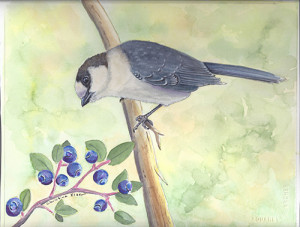
Gray Jay
All paintings by Christine Elder

